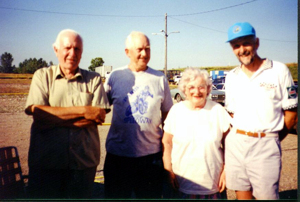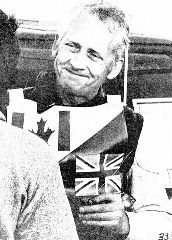|
|
Stan Bradbury's Speedway Training Notes
 |
 |
| L-R Secretary of the Veteran Speedway Riders Association, Stan Bradbury, Secretary's wife, and Ian March - 1996 |
Stan riding in 1978 |
FOREWORD
About the Author
Born in 1926 (also the official birth of speedway racing in Britain), he took an interest in grass track motorcycle racing in 1944 during the limited racing activity in Britain during World War 2. In 1945 he started practising in a field with a decrepit old, underpowered machine when he was 15 years of age. At 16 he was already racing "Bitzas" on the grass tracks within reasonable distance of his home and later used an ancient speedway machine (ancient in those days!) on the grass tracks. By this time the war was over and speedway racing was enjoying a great period of growth. He attended a training school at the famous Perry Bar, 1st Division Birmingham track in the winter of 1946-47 and was signed by the newly formed 3rd Division club Hanley after a successful trial at Bristol in the spring of 1947. Lack of funds and competitive equipment prevented him from competing in 1947 until the season was almost over when he had a disastrous "second half" ride at the Wigan Speedway track in which he fell and remounted on just about every turn.
During that winter he attended the Oliver Hart training school and became a confident rider. in the Spring, using a borrowed machine which had been well placed in the World Speedway Final at Wembley, he had very successful team trials at the Hanley track and was immediately signed to a long term contract. Unfortunately his own equipment was still sub-standard and he was unable to live up to the promise he showed at the team trials. He was still, good enough to maintain a full contract with the top 3rd Division team and stayed with them when the team was promoted to 2nd Division after winning the 3rd Division league title and the 3rd Division Knock-Out cup. While with Hanley he raced in Sweden against the emerging Swedes who were soon to dominate World Speedway for many years. While racing against the Swedish National Team he had the horrifying crash from which he escaped virtually without a scratch, a form of luck that persisted throughout his racing career.
He also raced in Ireland where he became better acquainted with Mike Tams, the Winnipeg born Canadian who raced for many years as a pro. in Britain before returning to Canada and his long association with speedway and Stan, in more recent times.
While with Hanley he rode in 16 meetings in 16 days which, with an average of three to six rides per meeting worked out to better than 72 heats of racing. This is almost the equivalent of two seasons of racing in Canada on a weekly basis, which serves to establish why so many experienced "pro" riders react automatically to certain race situations and also learn how to survive.
A transfer from Hanley to Motherwell saw him remove a cast from his left ankle in order to compete in team trials at Motherwell and be offered another full, long term contract. He stayed with that team against over two years, finding 2nd. Division no more difficult than 3rd. Division. The next move was to the tiny (by English standards) 2nd Division Wolverhampton track which he found difficult to master after two years of what was at that time, Britain's largest track. During his 2nd season, he was transferred to 2nd Division Liverpool which was on his doorstep, so to speak.
Disaster struck in the form of a crippling 33% gross tax on all admissions to Speedway tracks imposed by a near bankrupt government. This had the effect of wiping out most of the 38 or so tracks in Britain until only five survived. This put about 500 of the contracted professional Speedway riders out of work.
After a couple of years, stock car racing was introduced from the U.S.A. and the author took part in some of the earliest meetings staged in Britain with almost overnight success. After three years, the big money was no longer available and stock car racing had become a rich mans sport. At this time (I957) Stan, his wife Dorothy, and their first two children emigrated to Canada. In 1959 he helped with a venture to introduce Speedway at Dundas, Ontario which was unsuccessful. For some years after that, he and Mike Tams, Bob Fisher and a few other stalwarts did demonstrations at dirt stock car tracks around Southern Ontario, for about 10 years. After most stock car tracks were paved things went into limbo.
In the early winter of 1972 they met West Pierce at a Guelph indoor short track event and Wes told of his desire to use the track at Welland for regular dirt track meetings, and when speedway was discussed, he invited the group down to try out the track, when available. In the meantime Bob Fisher had once more found a dirt stock car track at Brighton, Ontario and regular demonstrations took place, to the delight of the spectators. The Robinson brothers of Spencerport near Rochester, New York, were interested in getting Speedway going and, heard about the small band of enthusiasts in Ontario.
A demonstration by Mike Tams and Stan at the Canadian Vintage Motorcycle Groups' rally at Welland ensured the inclusion of Speedway demonstration races at Welland the following year when Wes Pierce commenced his regular weekly short track events. The group also attended several short track events in New York state where in cooperation with the Robinson brothers and friends, speedway became established.
New York riders then helped to support the demonstration class at Welland and the rest is history. For the 8 years that the author raced at Welland, he was always well placed in the points standings and later, when speedway became a National Class, was well placed in the Canadian Championship. Knowing his racing career was coming to an end, he never invested in up-to-date equipment but instead used up his stock of venerable J.A.P. parts circa 1948-49 competing with riders half his age and using engines which produced only 80% of the power put out by the top machines at that time, the two valve Jawa DT500.
Now retired from active racing, he still enjoys a rapid circuit of the track which, at the time of writing, would have been competitive with most of the present 1st Division riders, particularly if mounted on similar equipment. He now devotes his time to helping other riders and potential riders (as he always has), taking an active part in the Canadian Speedway Racing Association, an organization of which he is one of the founding members. He also helped to run a small, non-profit, Speedway supply business in order to make all Speedway requirements available at the best possible prices. Many riders have had engines rebuilt or repaired, frames and forks straightened, welding, steel shoes made or repaired in his confined basement workshop-cum-stockroom.
This has enabled riders to race where they would otherwise have had their racing curtailed partially, or totally. He was rewarded in 1982 by being voted the "Best Motorcycle Mechanic in Ontario" a Norm Cornwell Memorial Award. An award voted on by the members of the Canadian Motorcycle Association and provided and sponsored by the Halton and Peel Off-Road Riders Association.
Although he was seldom brilliant as a rider and, in his opinion, not an outstanding mechanic, he achieved reasonable goals by his persistence and versatility. His notes are intended to pass on some of the knowledge gained over 40 years of racing experience, to those who are entering (or have recently entered) the sport of speedway that he loves and to which he has devoted so much of his time.
<-- Previous Page --- Next Page -->
Copyright Notice
|

